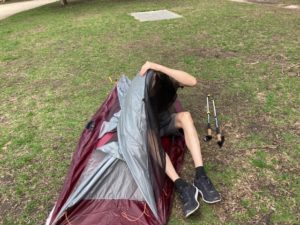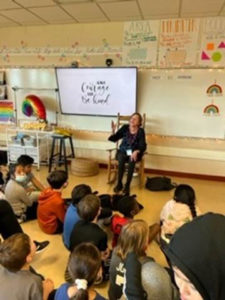Mondays with Mike: Spontaneity
April 25, 2022 • 5 Comments • Posted in Mike Knezovich, Mondays with MikeIt’s been happening steadily and gradually, and…Beth and I are busy again.
Busy as in going to plays, hearing music, joining friends for dinner—we went to see our son Gus a week ago and stayed overnight in Milwaukee.
We forgot how exhausting being busy can be. Fulfilling, but exhausting. (Play along and imagine that it has nothing to do with being two years older back when we were busy before covid.)
So last week we resolved to commit to nothing for this past weekend. Even if one of us brought up something that sounded kind of good, the other would scold: “We agreed not to schedule anything!”
And we ended up with a very enjoyable and full weekend. On Saturday—the nicest day of the year here in Chicago so far, our friend Colleen drove in from the burbs. We lunched at Roots, a place that opened just down the street from our place right before covid and somehow managed to survive. It was the first time Beth and I sat on the second floor—noteworthy because the place has an honest-to-god retractable roof. And it was retracted. It was glorious.
We spent the lunch catching up and enjoying a stiff breeze and the sunshine. It really is pretty cool up there. During lunch I got a text from our friend Jim. He was headed out to a local park to set up and test out a swell new tent he’d just gotten. But he ran into our friend Shannon, who was in town from the burbs with her toddler.

The rest of Jim is in there somewhere.
Toddler isn’t quite right. Sprinter is more like it. I saw him flying around at a distance but didn’t recognize him. He was bigger and faster. We hung out at our little plaza/park next to our building, and then headed to Dearborn Park, a proper park with lots of grass, to put Jim’s new purchase to the test.
Now, you should know that Jim is at least 6’5”. When he went looking for a one-person backpacking tent, that dimension was critical. And he found the perfect solution. An especially loooonnnng one-person tent.
The best thing about the tent? The name. It’s called the SoLong. Get it? Solo. Long. Solong! Turns out the tent itself is as clever as the name. It uses trekking poles for supports. Beth and Colleen and I watched as Jim assembled it, occasionally holding things down in a stiff wind.
I would call it’s maiden voyage a success. Hello SoLong! Beth and Colleen headed off for a walk and my backpack and I headed to the grocery store. Everywhere people smiled and laughed. Every outdoor café was full and buzzing with conversation. After what seemed like weeks of grey and cold, we were all liberated.
Some neighborhood friends had tickets to the Sunday 4:00 show at Jazz Showcase; they couldn’t use them. But we could! And did. And we heard a fantastic group: the Tom Harrell Quartet. On the walk in, a sign said that “at the request of the group’s management, we ask that you voluntarily wear masks.” We did, as did most in the crowd. Turns out that the bandleader, Tom Harrell, has both a heart and respiratory condition. In fact, he never stood up and played. He sat in a chair, bent over with his horn pointing downward. He’s 75, and clearly facing challenges. You might think that all sounds sad, but if you’d heard it, you’d have found it both remarkable and inspiring.
So an empty weekend turned, extemporaneously, into a busy and splendid one. There’s still a ways to go, but it’s fair to say, I think, that Chicago is back. And so are we.





